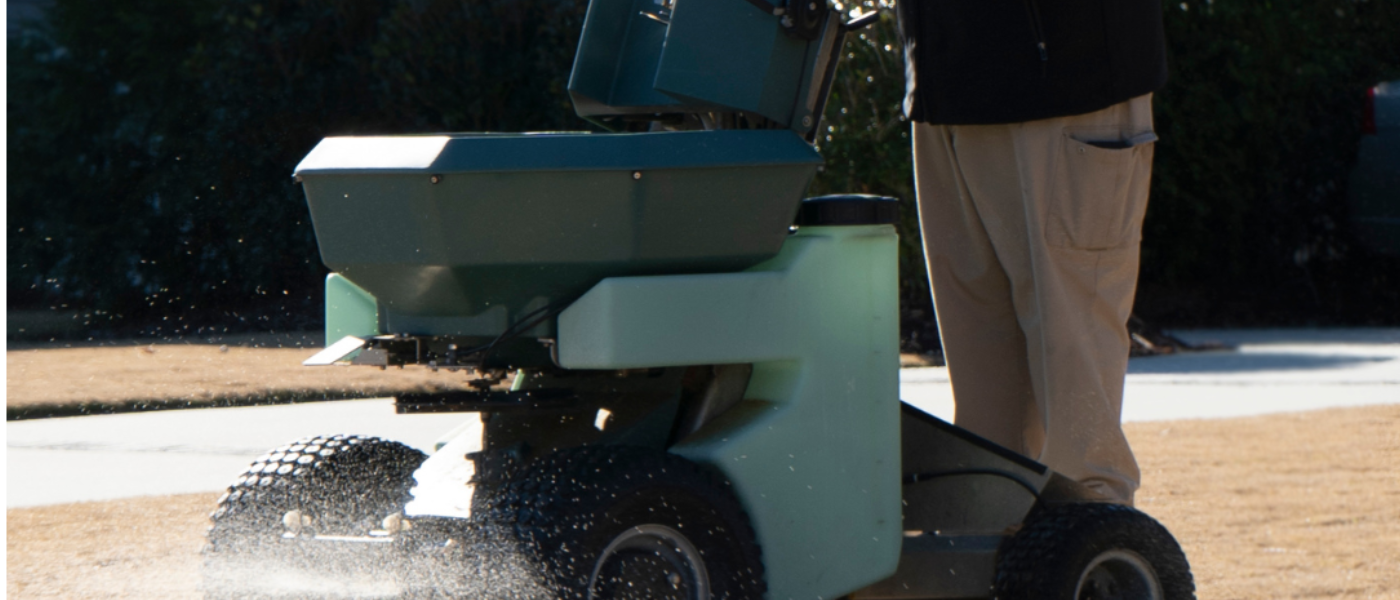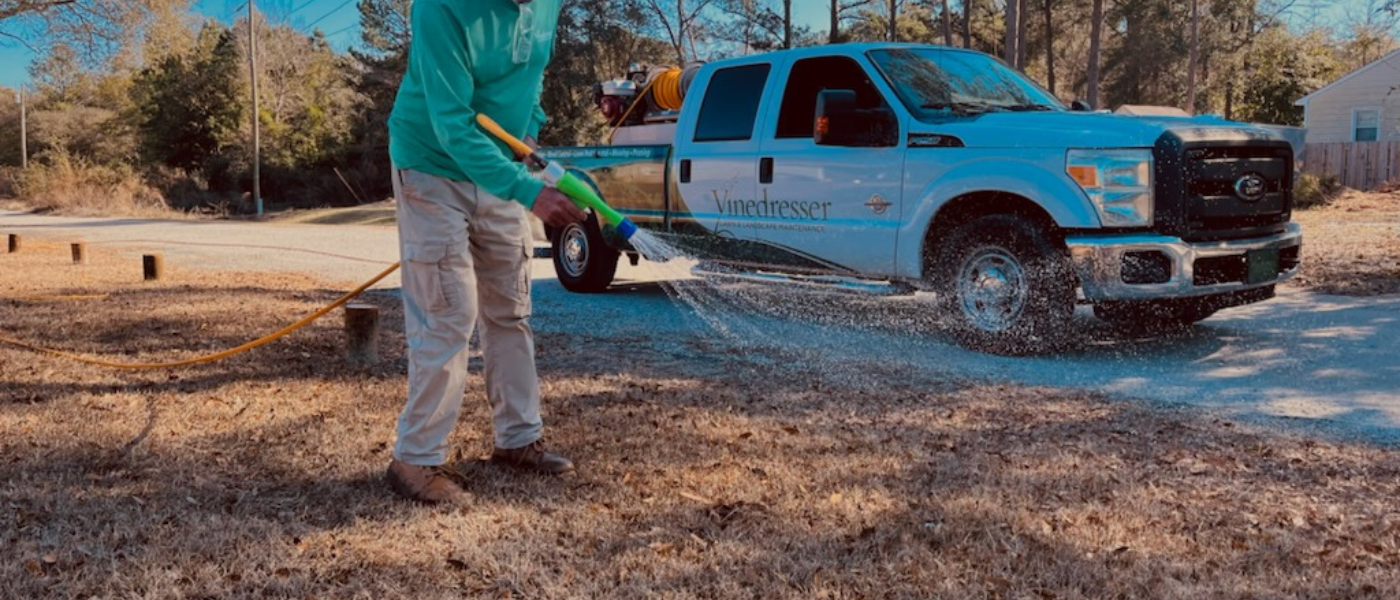Spring Pre-Emergent Herbicide Application in Wilmington, NC: The Ultimate Guide
In this guide to spring pre-emergent herbicides you will learn when, why, what to put down and so much more!
Welcome to Vinedresser Lawn and Landscape’s comprehensive guide on the crucial practice of spring pre-emergent herbicide application in the beautiful region of Southeastern North Carolina.
With our expertise and insights from a pivotal article by Fred Yelverton of NC State, this guide is tailored to help you navigate through the complexities of lawn care, ensuring your turf remains lush and weed-free throughout the year.
Section | Details |
Why Timing is Everything for Spring Pre-Emergent Application | – Key Points: Importance of timing due to warmer winters and early weed germination. Crabgrass Germination: Begins when soil temperatures reach 55 degrees for 3-4 consecutive days. Warmer Winters: Lead to earlier soil temperature increases, requiring earlier application. |
Monitoring Soil Temperatures: A Key Step in Pre-Emergent Application | – Tools & Tips: Use GreenCast for real-time soil temperature data and monitor trends for early application. Importance: Real-time data helps in making informed decisions to combat weed invasion effectively. |
The Top Three Pre-Emergents for Southeastern North Carolina Lawns | – Resolute 65WG (Prodiamine): Ideal for spring and fall with broad spectrum control and turf friendliness. Dimension 2EW Herbicide (Dithiopyr): Effective pre- and early post-emergence with dual-action formula. Spectacle Flow: Used primarily in the fall for long-lasting control against major weeds. |
Regional Recommendations for Pre-Emergent Application | – Central North Carolina: Apply by the end of February. Eastern North Carolina: Mid-February is ideal. Western NC and Higher Elevations: Target early March for application. Rationale: Recommendations based on local soil temperatures and weather patterns. |
Practical Tips for Effective Pre-Emergent Application | – Split Application Strategy: Start in January/February and apply the second round in March/April. Best Practices: Follow label instructions, consider soil moisture, and account for weather conditions. Purpose: Ensures comprehensive weed control and accommodates unpredictability of weather and soil conditions. |
Why Timing is Everything for Spring Pre-Emergent Application
Effective weed management really boils down to getting your timing right. As the winter months get warmer, those pesky weeds, like crabgrass, start waking up and sprouting earlier than they used to. This means we’ve got to be on our toes and adjust when we put down our weed preventers.
Key Points:
- Crabgrass Germination: This sneaky weed begins its growth spurt when the soil’s warmth holds steady at about 55 degrees for a few days in a row. Basically, if the soil feels like a nice spring day, crabgrass thinks it’s time to party.
- Warmer Winters: Unfortunately, winters aren’t as chilly as they used to be. This warmth means our soil heats up sooner, nudging crabgrass to start growing earlier in the year. Consequently, we have to be ready to act sooner than we might have planned.
Monitoring Soil Temperatures: A Key Step in Pre-Emergent Application
Having real-time soil temperature data at your fingertips is super important for deciding exactly when to start your weed-fighting mission. It’s like having a secret weapon that tells you the best time to strike against those unwanted lawn invaders.
Tools & Tips:
- Stay Updated with GreenCast Soil Temp Map: This tool is a game-changer. It gives you the latest scoop on soil temperatures right where you are. Think of it as your personal lawn care advisor, always ready to tell you when it’s time to take action.
- Keep an Eye on Trends: Besides just knowing the current temperature, it’s smart to look at how things are changing over time. If you notice that the ground is warming up faster than usual, it’s a heads-up that you might need to get moving with your pre-emergent application sooner than you thought.
Using tools like GreenCast’s soil temp map isn’t just about numbers and data; it’s about giving you the confidence to make decisions that keep your lawn looking amazing. It’s pretty easy to get the hang of, and once you start using it, you’ll wonder how you ever managed without it.
Moreover, by monitoring soil temperature trends, you’re not just reacting to what’s happening now. You’re anticipating what’s coming next, which is key in staying ahead of weeds. This proactive approach can save you a lot of hassle and ensure your lawn stays in top shape.

The Top Three Pre-Emergents for Southeastern North Carolina Lawns
Choosing the right spring pre-emergent herbicide is crucial for keeping your lawn in pristine condition. Let’s dive into three top picks that cater to different needs and seasons, ensuring your turf stays lush and weed-free all year round.
Resolute 65WG (Prodiamine)
Ideal Time to Apply: Spring and Fall
Why It’s a Favorite:
- Broad Spectrum Control: It knocks out a wide variety of pesky grass and broadleaf weeds before they can start causing trouble.
- Turf Friendly: Whether you’re growing St. Augustine, Bermuda, or Fescue, Resolute 65WG has got you covered. It’s designed to be safe across these common turf types, making it a versatile choice for many lawns.
Dimension 2EW Herbicide (Dithiopyr)
Best For: Pre- and Early Post-Emergence
Key Features:
- Dual-Action: Not only does it prevent weeds from germinating, but it also tackles young crabgrass that’s already sprouted. This makes Dimension 2EW a powerful ally in your weed control arsenal.
- Wide-Ranging Effectiveness: This herbicide isn’t picky; it targets a broad array of grasses and broadleaf weeds, ensuring your lawn stays clean and clear.
Spectacle Flow
When to Use: Primarily in the Fall
Major Perks:
- Long-Lasting Defense: With up to eight months of residual control, Spectacle Flow is a set-it-and-forget-it solution for major weed worries.
- Targeted Action: It’s especially effective against stubborn invaders like crabgrass and poa annua, making it a crucial part of your fall lawn care routine.
Pre-Emergent Application Windows by Region of North Carolina
Central North Carolina
Deadline: By the end of February
Why? This region sees a mix of weather patterns, but soil temperatures start warming up early. Applying pre-emergents by the end of February helps nip early germinating weeds in the bud.
Eastern North Carolina
Ideal Time: Mid-February
Reason: Closer to the coast, this area warms up a bit sooner. Getting your pre-emergents down by mid-February ensures you’re beating the weeds before they even think about sprouting.
Western NC and Higher Elevations
Target Window: Early March
Explanation: The higher elevations and western parts of the state tend to stay cooler for longer. This gives you a little extra time, but don’t wait too long! Early March is your sweet spot to prevent weeds from taking hold.
Why Timing Matters
Each of these recommendations takes into account local soil temperatures and typical weather patterns. The goal is to apply your spring pre-emergent herbicide just before weed seeds start to germinate. Doing so creates a barrier that stops them in their tracks, keeping your lawn clean and clear.
Tips for Success
- Monitor Local Soil Temperatures: Conditions can vary year to year, so keep an eye on current soil temperatures for the most accurate timing.
- Stay Flexible: Be ready to adjust your application timing based on the current year’s weather patterns. A mild winter might mean applying earlier, while a colder season could give you more time.

Practical Tips for Effective Pre-Emergent Application
Implementing a practical approach to pre-emergent application can significantly enhance your lawn’s health and appearance. A split application strategy, in particular, offers thorough weed control, ensuring your turf remains robust and weed-free throughout the growing season. Here are some straightforward strategies to maximize the effectiveness of your pre-emergent applications:
Split Application Strategy Explained
First Round: January and February
- Why? Kickstarting your weed control early in the year tackles weeds before they have a chance to germinate and take root.
- Benefit: This early intervention acts as the first line of defense, preventing the initial wave of weeds from establishing in your lawn.
Second Round: March and April
- Purpose: This follow-up application targets any weeds that might have slipped through the first barrier, providing an additional layer of protection.
- Advantage: Ensures comprehensive coverage and control, catching any late bloomers and reinforcing your lawn’s defense against weeds.
Best Practices for Application
- Follow Label Instructions: Each herbicide comes with specific guidelines for optimal use. Adhering to these instructions ensures the safety and effectiveness of the product.
- Consider Soil Moisture: Pre-emergents require proper soil moisture to activate. Too dry, and the product may not work as intended; too wet, and it could dilute, reducing its efficacy.
- Account for Weather Conditions: Ideal application times can vary based on the current weather. A sudden warm spell or unexpected frost can influence the best time to apply your pre-emergent.
Why This Matters
Using a split application strategy not only maximizes your lawn’s protection against weeds but also accommodates for the unpredictability of weather and soil conditions. By starting early and reinforcing your lawn’s defense with a second round of application, you significantly reduce the chances of weed invasion.
This approach also allows for flexibility, giving you the opportunity to adjust your application based on real-time conditions, ensuring that your lawn receives the best possible care at the optimal time.
Final Thoughts
In wrapping up, the key to maintaining a vibrant, weed-free lawn in Southeastern North Carolina lies in the timely and precise application of pre-emergent herbicides. By implementing the strategies discussed, such as monitoring soil temperatures, adapting to regional application windows, and employing a split application method, you can effectively prevent weeds from gaining a foothold in your lawn.
Remember, every lawn is unique, and factors like soil type, local climate, and turf species play significant roles in determining the best lawn care approach. Staying proactive, informed, and adaptable in your pre-emergent application strategy is essential for achieving and maintaining the lush, green lawn you desire.
Contact Vinedresser Lawn & Landscape
If you’re looking for personalized lawn care solutions or need expert guidance on pre-emergent herbicide application, Vinedresser Lawn and Landscape is here to help. Our team of lawn care professionals is dedicated to ensuring your lawn not only survives but thrives throughout the year.
Don’t let weeds take over your beautiful lawn. Contact Vinedresser Lawn and Landscape today, and let’s work together to keep your outdoor space looking its best. Whether you need advice on the right pre-emergent product or a comprehensive lawn care plan, we’re ready to assist you every step of the way.
